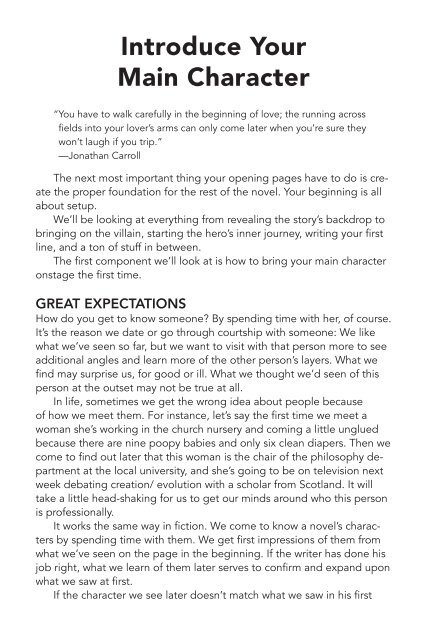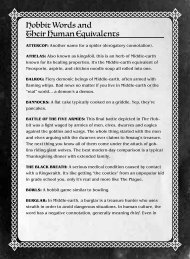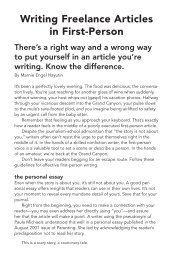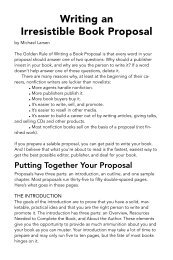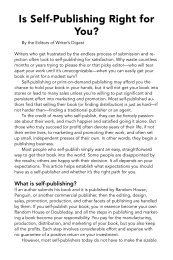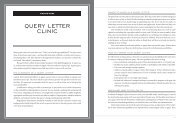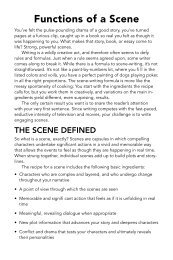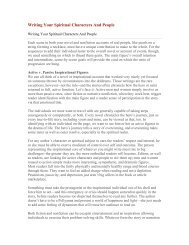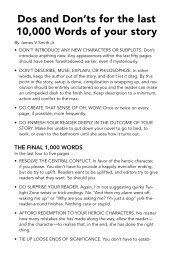Introduce Your Main Character - Writer's Digest
Introduce Your Main Character - Writer's Digest
Introduce Your Main Character - Writer's Digest
- No tags were found...
Create successful ePaper yourself
Turn your PDF publications into a flip-book with our unique Google optimized e-Paper software.
The process we’re working on is twofold: 1) isolate the primary characteristic,and 2) depict that characteristic in a scene. And, obviously, theprerequisite for this is to identify your main character’s primary characteristic.So what is it for your protagonist?What if your hero were a woman so out of touch with her femininitythat she fits in more with the guys than the girls, including the morenegative aspects of traditional masculinity like a fierce independence thatdefies protocol and authority?As you think about how to do this, you’re necessarily factoring in elementswe haven’t gone over yet, like genre and setting and era. That’swhat I mean by how we could have talked about these components inany order. For now, don’t let those other aspects of the story intrude.Think only of your hero’s essence and how that might be illustrated in ascene. You can think later about how to plant that in your particular storyworld.That implantation is actually easy once you have this part figured out.It’s much harder to look at your story world and the mandates it puts onyou and only then try to come up with a character’s core and how to illustrateit. In writing fiction, it’s almost always best to go from the theoreticalto the practical rather than the other way around.Take some time right now to figure out your hero’s essential characteristic.Then take another few minutes to brainstorm four or five waysthat characteristic could come out in a scene. You don’t have to decideon one yet. Indeed, there are a number of other elements to considerbefore locking down that introductory scene. But this task—revealing hercore in a scene—is the main part.CAN’T YOU JUST PICTURE IT?If your hero were to have his portrait made, how would he want to appear?I’m not talking about modern portraits where all you get to choosefrom is the black backdrop, the white backdrop, or the forest backdropwith the fencepost prop. I’m talking about old-school portraits, like thosepaintings done in the Renaissance, in which a person’s portrait includedelements that conveyed much about his passions, history, and life.
such a portrait? What elements would need to be in the image to give asnapshot of his character?Then take the exercise a step further: Create a little movie scenethat captures your hero in her element. For this, don’t worry about yourbook’s genre or setting or anything else. If she could be doing anythingat all, in any time in world history (or in any otherworldly future or dimension),what would it be? This is the place to ask, “If she could drive theultimate car, what would it be?”—even if your character will live in a timewhen there are no cars. Go a little crazy as you search for the best possiblefit for your character.The idea is to identify for yourself what he’s really like. If this characterwere transported to the Twilight Zone and allowed to gravitate to theultimate-for-him activity, what would it be?Would he be lazing by the pool sipping a cold drink with a little umbrellain it—while dozens of rescued orphans had fun in the pool? Wouldshe be floating in space repairing a battlecruiser in the middle of a warwith the Zudokons? Would he be living high above the forest in the boleof a tree where he spends his days writing love sonnets?What would she be doing? With whom would he be? What wouldshe be wearing? What would he be talking or thinking about? Mostimportant of all: Why would this be what the character chose? How is thisthe ultimate expression or revelation of the person’s core?When you’ve got this down, you’re ready to bring your hero onstagefor the first time.If you’re a plot-first novelist, you may be wondering why I’m “wasting”your time making you think about character stuff, but I assure youthis work will pay dividends when you begin writing your novel.Doing this work gives you a handle on who your hero really is. Whenshe gets into a tight spot and you’re not sure what she would do, comeback to this little scene simulation and read it again. It will reconnect youwith your character’s core, and that will give you a clue on how she wouldrespond in that situation.Incidentally, there’s much more to character creation than just this.In Plot Versus <strong>Character</strong>, this idealized self-portrait scene exercise is thefinal bit of work we do to be sure we know our character. So you’d do thisplus a lot more before this. But if you’re in a hurry to write or you’re notyet convinced that character homework is required or if you’ve alreadydone that work, this will at least help you as you begin to write yourbook.
has a knack for creating wonderful minor characters, as evidenced by hisbrief but brilliant roles in The Wedding Singer, Three Amigos, and more.Actually, the writers created those characters. That’s your job.In Sneakers, Liz (played by Mary McDonnell) is the romantic interest.The first time we meet her, she’s in an elite conservatory school workingwith a gifted young pianist. Everything about her surroundings, job,dress, and demeanor bespeak class—quite a contrast to the ratty bluejeans and, well, sneakers of her erstwhile boyfriend.The first time we meet Cal (Billy Zane’s character in Titanic), whobecomes the antagonist, he shows himself to be an arrogant, pompousaristocrat who treats servants as property and keeps his fiancée on ashort leash. We dislike him within the first thirty seconds he’s onscreen.That’s a great character introduction.<strong>Your</strong> secondary characters don’t need as thorough an introduction asyour protagonist, but they do merit careful thought for how you’re goingto bring them onstage the first time.REMEMBER THE IMPORTANCE OFFIRST IMPRESSIONSHow will you introduce your main character? If you’re starting the bookwith your protagonist onstage, you’ll need to engage with action in additionto the other things we’ve talked about in this chapter. Not only willyou need to reveal who your hero is at his core and how that is expressedin your specific story, you’ll also need to package it in a scene that is interestingindependent of anything you’re doing with the main character.So how will you do it? What’s your hero’s essential ingredient? We’lltalk next about the other active ingredients that go into your character introduction.But by now you should be beginning to have some ideas notonly for what needs to be done in that introduction but about how youmight pull it off.Think of your character introductions as short stories, little standaloneshort films created for the purpose of presenting your main charactersto your reader. They will serve not only as introduction but as résuméand business card, brief snapshots conveying the essence of who thesepeople are.Most of the novelists I’ve worked with over the years do not naturallythink to construct introductory short stories like this. They just want to getgoing with the main story, and they give almost no thought to how thereader will encounter the hero. But doing so with care is essential to getthe protagonist “set” in the reader’s mind. Watch some movies and seehow the main characters are introduced. Then sit down and write a short
story to introduce your hero.Remember to show what is likable about your protagonist. That’swhere chapters four and five overlap—you engage your reader by introducingyour hero in a way that shows what’s heroic or sympathetic abouther. Make us care about her.First impressions are so powerful, especially in fiction. They shape everyexpectation we have about what this person is going to be like in thefuture. In a sense, they are deterministic of the future. In the character’sintroduction is the seed of the whole story. We see, in embryonic form,who he is, what makes him heroic, and where he is going.


